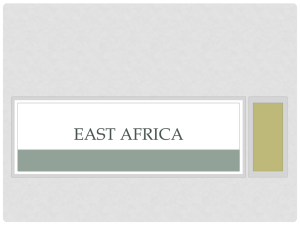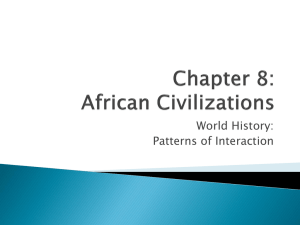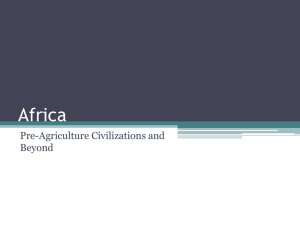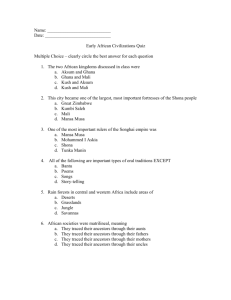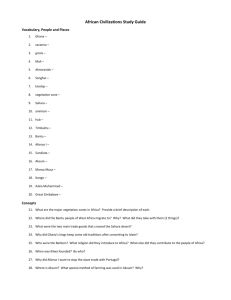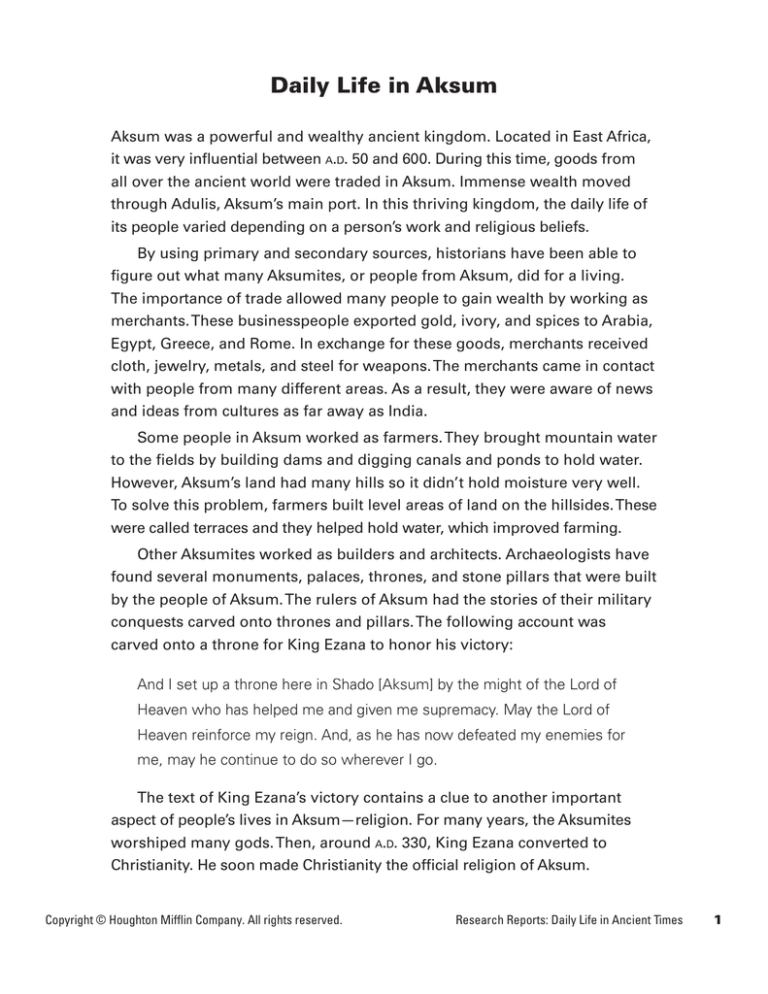
Daily Life in Aksum
Aksum was a powerful and wealthy ancient kingdom. Located in East Africa,
it was very influential between A.D. 50 and 600. During this time, goods from
all over the ancient world were traded in Aksum. Immense wealth moved
through Adulis, Aksum’s main port. In this thriving kingdom, the daily life of
its people varied depending on a person’s work and religious beliefs.
By using primary and secondary sources, historians have been able to
figure out what many Aksumites, or people from Aksum, did for a living.
The importance of trade allowed many people to gain wealth by working as
merchants. These businesspeople exported gold, ivory, and spices to Arabia,
Egypt, Greece, and Rome. In exchange for these goods, merchants received
cloth, jewelry, metals, and steel for weapons. The merchants came in contact
with people from many different areas. As a result, they were aware of news
and ideas from cultures as far away as India.
Some people in Aksum worked as farmers. They brought mountain water
to the fields by building dams and digging canals and ponds to hold water.
However, Aksum’s land had many hills so it didn’t hold moisture very well.
To solve this problem, farmers built level areas of land on the hillsides. These
were called terraces and they helped hold water, which improved farming.
Other Aksumites worked as builders and architects. Archaeologists have
found several monuments, palaces, thrones, and stone pillars that were built
by the people of Aksum. The rulers of Aksum had the stories of their military
conquests carved onto thrones and pillars. The following account was
carved onto a throne for King Ezana to honor his victory:
And I set up a throne here in Shado [Aksum] by the might of the Lord of
Heaven who has helped me and given me supremacy. May the Lord of
Heaven reinforce my reign. And, as he has now defeated my enemies for
me, may he continue to do so wherever I go.
The text of King Ezana’s victory contains a clue to another important
aspect of people’s lives in Aksum—religion. For many years, the Aksumites
worshiped many gods. Then, around A.D. 330, King Ezana converted to
Christianity. He soon made Christianity the official religion of Aksum.
Copyright © Houghton Mifflin Company. All rights reserved.
Research Reports: Daily Life in Ancient Times
1
Eventually, Christianity spread throughout the region. Monks brought the
Christian message to the interior of Aksum. They also replaced local temples
and shrines with Christian churches and monasteries.
Learning was also important in the lives of some Aksumites. The written
language of Aksum was called Ge’ez. It is a form of Arabic that has been
modified by the Greek and Kushitic languages. Part of why we know so
much about Aksum is because the Aksumites preserved their rulers’ written
documents.
The daily lives of Aksumites varied depending on their work. Aksumites
worked as merchants, farmers, builders, architects, and monks. The
Christian religion became important in many of their lives, starting with the
conversion of King Ezana around A.D. 330. The Aksumites also emphasized
learning by preserving their history through written documents.
Bibliography
Primary Sources
Ezana. “DAE 11.” in Stuart Munro-Hay. An African Civilization of Late
Antiquity. ed. Alan Light. 1991. May 27, 2005. <http://users.vnet.net/alight/
Antiquity
aksum/mhak4.html#c11-5-dae11>.
Web sites
“Aksum.” Encyclopaedia Britannica Online.
Online May 27, 2005. <http://www.
eb.com/>.
“eastern Africa, history of.” Encyclopaedia Britannica Online.
Online May 27,
2005. <http://www.eb.com/>
<http://www.eb.com/>.
“The Kingdom of Aksum.” About.com. May 27, 2005. <http://www.about.
com/>.
Encyclopedia articles
Rowe, John A. “Ethiopia.” The World Book Multimedia Encyclopedia.
Encyclopedia 2001.
Spitzer, Leo. “Aksum.” The World Book Multimedia Encyclopedia.
Encyclopedia 2001.
Books
McDougal Littell. World History: Ancient Civilizations.
Civilizations Evanston:
McDougal Littell, a division of Houghton Mifflin Company, 2006. 197–200.
Copyright © Houghton Mifflin Company. All rights reserved.
Research Reports: Daily Life in Ancient Times
2
Daily Life in Aksum
Organization
A research report has three basic parts: the introduction, the body, and the
conclusion. The introduction gives background and states the topic. The body
provides engaging details on the topic and the conclusion summarizes the
information. What aspect of daily life in Egypt or Kush will you write about?
Daily Life in Aksum
introduction
Aksum was a powerful and wealthy ancient kingdom. Located in East
background
Africa, it was very influential between A.D. 50 and 600. During this time,
goods from all over the ancient world were traded in Aksum. Immense
wealth moved through Adulis, Aksum’s main port. In this thriving kingdom,
the daily life of the people varied depending on a person’s work and
topic
religious beliefs.
By using primary and secondary sources, historians have been able to
figure out what many Aksumites, or people from Aksum, did for a living.
The importance of trade allowed many people to gain wealth by working
as merchants. These businesspeople exported gold, ivory, and spices to
details
Arabia, Egypt, Greece, and Rome. In exchange for these goods, merchants
body
received cloth, jewelry, metals, and steel for weapons. The merchants came
in contact with people from many different areas. As a result, they were
aware of news and ideas from cultures as far away as India.
Some people in Aksum worked as farmers. They brought mountain
details
water to the fields by building dams and digging canals and ponds to hold
water. However, Aksum’s land had many hills so it didn’t hold moisture
very well. To solve this problem, farmers built level areas of land on the
hillsides. These were called terraces and they helped hold water, which
improved farming.
Copyright © Houghton Mifflin Company. All rights reserved.
Research Reports: Daily Life in Ancient Times
3
Daily Life in Aksum (continued)
Other Aksumites worked as builders and architects. Archaeologists
have found several monuments, palaces, thrones, and stone pillars that
were built by the people of Aksum. The rulers of Aksum had the stories
details
of their military conquests carved onto thrones and pillars. The following
account was carved onto a throne for King Ezana to honor his victory:
And I set up a throne here in Shado [Aksum] by the might of the Lord
of Heaven who has helped me and given me supremacy. May the
Lord of Heaven reinforce my reign. And, as he has now defeated my
body
enemies for me, may he continue to do so wherever I go.
The text of King Ezana’s victory contains a clue to another important
aspect of people’s lives in Aksum—religion. For many years, the Aksumites
worshiped many gods. Then, around A.D. 330, King Ezana converted to
details
Christianity. He soon made Christianity the official religion of Aksum.
Eventually, Christianity spread throughout the region. Monks brought
the Christian message to the interior of Aksum. They also replaced local
temples and shrines with Christian churches and monasteries.
Learning was also important in the lives of some Aksumites. The
written language of Aksum was called Ge’ez. It is a form of Arabic that has
details
been modified by the Greek and Kushitic languages. Part of why we know
so much about Aksum is because the Aksumites preserved their rulers’
written documents.
conclusion
The daily lives of Aksumites varied depending on their work. Aksumites
worked as merchants, farmers, builders, architects, and monks. The
summary
Christian religion became important in many of their lives, starting with the
conversion of King Ezana around A.D. 330. The Aksumites also emphasized
learning by preserving their history through written documents.
Copyright © Houghton Mifflin Company. All rights reserved.
Research Reports: Daily Life in Ancient Times
4
Daily Life in Aksum (continued)
Engaging Details
Details can provide a deeper understanding of the history of a particular time period
and make your research report more interesting to the reader. Research reports can
use engaging details about the objects, the activities and behaviors, and the laws,
rules, or rituals of a culture. What details will you provide to describe daily life in
Egypt or Kush?
The importance of trade allowed many people to gain wealth by working as
objects
merchants. These businesspeople exported gold, ivory, and spices to Arabia,
Egypt, Greece, and Rome. In exchange for these goods, merchants received
cloth, jewelry, metals, and steel for weapons.
Some people in Aksum worked as farmers. They brought mountain
water to the fields by building dams and digging canals and ponds to hold
activities
water. However, Aksum’s land had many hills so it didn’t hold moisture very
well. To solve this problem, farmers built level areas of land on the hillsides.
These were called terraces and they helped hold water, which improved
farming.
The rulers of Aksum had the stories of their military conquests carved onto
behaviors
thrones and pillars. The following account was carved onto a throne for
King Ezana to honor his victory:
And I set up a throne here in Shado [Aksum] by the might of the Lord of
Heaven who has helped me and given me supremacy. May the Lord of
Heaven reinforce my reign. And, as he has now defeated my enemies for
me, may he continue to do so wherever I go.
Copyright © Houghton Mifflin Company. All rights reserved.
Research Reports: Daily Life in Ancient Times
5
Daily Life in Aksum (continued)
For many years, the Aksumites worshiped many gods. Then, around A.D.
330, King Ezana converted to Christianity. He soon made Christianity the
laws, rules
or rituals
official religion of Aksum. Eventually, Christianity spread throughout the
region. Monks brought the Christian message to the interior of Aksum.
They also replaced local temples and shrines with Christian churches and
monasteries.
Copyright © Houghton Mifflin Company. All rights reserved.
Research Reports: Daily Life in Ancient Times
6
Daily Life in Aksum (continued)
Bibliography
A bibliography lists the sources used for writing a research report. Remember, your
bibliography for this assignment should contain a primary source, a Web site, an
encyclopedia article, and a book. If possible, each citation should include the title,
author, publisher, date, page number, or Web address. When you have more than
one source in a category you should list them alphabetically. Use the format below
for your bibliography.
Primary Sources
Ezana. “DAE 11.” in Stuart Munro-Hay. An African Civilization of Late
Antiquity. ed. Alan Light. 1991. May 27, 2005. <http://users.vnet.net/alight/
Antiquity
aksum/mhak4.html#c11-5-dae11>.
Web sites
“Aksum.” Encyclopaedia Britannica Online.
Online May 27, 2005. <http://www.
eb.com/>.
“eastern Africa, history of.” Encyclopaedia Britannica Online.
Online May 27, 2005.
<http://www.eb.com/>.
<http://www.eb.com/>
“The Kingdom of Aksum.” About.com. May 27, 2005. <http://www.about.
com/>.
Encyclopedia articles
Rowe, John A. “Ethiopia.” The World Book Multimedia Encyclopedia.
Encyclopedia 2001.
Spitzer, Leo. “Aksum.” The World Book Multimedia Encyclopedia.
Encyclopedia 2001.
Books
McDougal Littell. World History: Ancient Civilizations.
Civilizations Evanston: McDougal
Littell, a division of Houghton Mifflin Company, 2006. 197–200.
Copyright © Houghton Mifflin Company. All rights reserved.
Research Reports: Daily Life in Ancient Times
7

